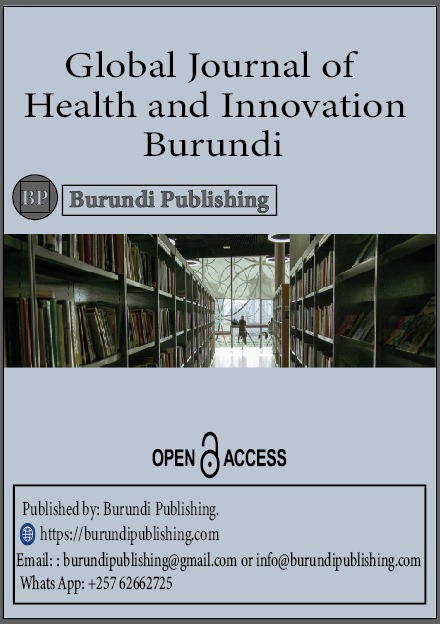FACTORS CONTRIBUTING TO NON-ADHERENCE TO ANTIBIOTICS AMONG THE YOUTH ATTENDING ST. FRANCIS HOSPITAL NSAMBYA, KAMPALA DISTRICT, A CROSS-SECTIONAL STUDY
DOI:
https://doi.org/10.70659/gjhib.v2i8.18Keywords:
Non-Adherence, Antibiotics, St. Francis Hospital Nsambya, Kampala DistrictAbstract
Background
Non-adherence to antibiotics among youth is a serious health issue that can lead to antibiotic resistance and prolonged illness. This study aimed to identify the factors contributing to non-adherence to antibiotics among youth attending St. Francis Hospital, Nsambya, in Kampala District.
Methodology
A descriptive cross-sectional study design with a simple random sampling technique was employed; data were collected from a sample of 50 respondents using a semi-structured questionnaire with closed-ended questions as the data collection tool. Data was later analyzed manually using tally sheets, computed into frequencies and percentages using the Microsoft Excel program with bar graphs, pie charts, and tables for easier interpretation.
Results
50 respondents participated in this study, 26 were males, while 24 were females. 56% of the respondents were between 21-25 years of age, whereas the least of the respondents (24%) were in the age range of 15-20 years. The majority, 64% of the respondents, were single, and a minority (4%) were divorced. 42% of the respondents found it difficult to purchase antibiotics 60% of the respondents didn’t have health literature about antibiotic medications. 40% stopped taking the antibiotic medications as the symptoms and signs stopped. 36% were strongly influenced by friends (peers), and 40% didn’t think it was essential to finish the antibiotic dose. 52% of the respondents had poor health care provider relationships with patients and didn’t follow up on their patients’ medications.
Conclusion
Poor knowledge and a health care provider relationship with patients, little or no information given to the patients about the antibiotics, and no follow-up of medications by the patients proved to be a hindering factor to adherence
Recommendations
Awareness of antibiotic resistance among patients of the outpatient department and neighboring communities is to be conducted
References
Haider, S., Rashid, H., Uttra, A., Khan, M., Usman, M., Nadeem, W., Zaman, G., Ahmed, F., & Mumtaz, T. (2024). SOCIOECONOMIC AND BEHAVIORAL FACTORS CONTRIBUTING TO ANTIBIOTICS NON-ADHERENCE. 05. https://doi.org/10.56536/ijpihs.v5i1
Jimmy, B., & Jose, J. (2011). Patient Medication Adherence: Measures in Daily Practice. Oman Medical Journal, 26(3), 155–159. https://doi.org/10.5001/omj.2011.38
Voidăzan, S., Moldovan, G., Voidăzan, L., Zazgyva, A., & Moldovan, H. (2019). Knowledge, Attitudes And Practices Regarding The Use Of Antibiotics. Study On The General Population Of Mureş County, Romania. Infection and Drug Resistance, 12, 3385–3396. https://doi.org/10.2147/IDR.S214574
Aljayyousi, G. F.-R.-H. (2019). Public practices on antibiotic use: A cross-sectional study among Qatar University students and their family members. PLos One, 14(11).
Almomani, B. A. (2022). Prevalence and predictors to short-term antibiotics: A population-based survey. Plos one, 17, 5.
Chen, Y. C. (2015). Factors influencing adherence to antibiotic therapy in patients with acute infections. Hu li za zhi, 62(1), 58.
Dache, A. D. (2021). Inappropriate use of antibiotics, its reasons and contributing factors among communities of Yirgalem town, Sidama regional state, Ethiopia: Cross-sectional study. SAGE Open Medicine, 9.
Endashaw Hareru, H. S. (2022). Antibiotic non-adherence and its associated factors among households in southern Ethiopia. SAGE Open Medicine, 10.
Faure, H. G.-B. (2014). Assessment of patient adherence to anti-infective treatment after returning home. Medecine et malaides infectieuses, 44(9), 417-422.
Fernandes, M. L. (2014). Non-adherence to antibiotic therapy in patients visiting community pharmacies. International journal of clinical pharmacy, 36, 86-91.
Fernandes, M. L. (n.d.). Non-adherence to antibiotic therapy in patients visiting community pharmacies. International Journal of clinical pharmacy, 36(1), 86-91. Retrieved from https://doi.org/10.1007/s11096-013-9850-4
Green, D. L. (2023). The role of multidimensional povertyin antibiotic misuse: a mixed-methods study of self-medication and non adherence in Kenya, Tanzania and Uganda. The Lancet Global Health, 11(1), e59-e68.
Green, D. L. (n.d.). The role of mltidimensional poverty in antibiotic misuse: a mixed-methods study of self-medication and non adherence in Kenya, Tanzania and Uganda. The Lancet Global Health, 11(1), e59-e68.
Haider, S. H. (2024). SOCIOECONOMIC AND BEHAVIORAL FACTORS CONTRIBUTING
TO ANTIBIOTICS NON ADHERENCE. International Journal of Pharmacy & Intergrated Health Sciences, 5(1).
Hanghoj, S. &. (2014). Self-reported barriers to medication adherence among chronically ill adolescents: a systemic review. Journal of adolescent health, 54(2), 121-138.
Hossain, M. J. (2023). Irrational use of antibiotics of antibiotics and factors associated with antibiotic resistance: findings from a cross sectional study in Bangladesh. Health Science Reports, 6(8).
Kagoya, E. K. (2021). Experiences and views of healthcare proffessinals on the prescription of antibiotics in Eastern Uganad: A qualitative study. Journal of Global antimicrobial resistance, 25, 66-71.
Lam, W. Y. (2015). Medication adherence measures: an overview. BioMed research international 2015.
Mohiuddin, A. K. (2019). Risks and reasons associated with medication non-adherence. J Clin Pharm, 1(1), 50-53.
Obakiro, e. a. (2022). Are antibiotic prescription practices in Eastern Uganda concordant with the National Treatment Guidelines? A cross sectional retrospective study. Journal of Global Antimicrobial Resistance, 29, 513-519.
Osterberg, L. &. (2005). Adherence to medication. New Engand journal of medicine, 353(5), 487-497.
Sabate, E. (2003). Adherence to long term therapies: evidence for action. World Health Organisation.
Shemsedin, R. &. (2015). Community drug retail outlet services. International Journal of Pharmaceutical Sciences in Research, 6(3).
Stewart, S. J. (2023). Medication non adherence: health impact, prevalence, correlates and interventions. Psychology & health, 38(6), 726-765.
Subhan Haider, H. R. (2024). INTERNATIONAL JOURNAL OF PHARMACY &
INTERGRATED HEALTH SCIENCES. Retrieved from https;//ijpihs.pk/index.php/IJPIHS/ article/view/87
Subhan Haider, H. R. (2024). SOCIOECONOMIC AND BEHAVIORAL FACTORS
CONTRIBUTING TO ANTIBIOTICS NON-ADHERENCE. International Journal of Pharmacy & Intergrated Health Sciences, 5(1).
Tong, S. P. (2018). Patient compliance with antimicrobial drugs: A Chinese survey. American journal of infection control, 46(4).
Voidazan, S. M. (2019). Knowledge, Attitudes and Practices Regarding The use of antibiotics.
Study ON The General Population of Mures County, Romania. Infection and Drug Resistance, 12, 3385-3396.
Yin, X. G. (2022). Pevalence of inappropriate use behaviors of antibiotics and related factors among chinese antibiotic users: an online cross-sectional survey. BMC Infectious diseases, 22(1), 689.
Downloads
Published
How to Cite
Issue
Section
License
Copyright (c) 2025 Patience Emmanuela Mbegbu, Sania Nakasolo.

This work is licensed under a Creative Commons Attribution 4.0 International License.
License Information
All articles published in the Global Journal of Health and Innovation Burundi are licensed under the Creative Commons Attribution 4.0 International License (CC BY 4.0).
This license permits:
- Sharing: You can copy and redistribute the material in any medium or format.
- Adapting: You can remix, transform, and build upon the material for any purpose, including commercially.
Attribution Requirement: Users must provide appropriate credit to the original author(s), link to the license, and indicate if changes were made.






